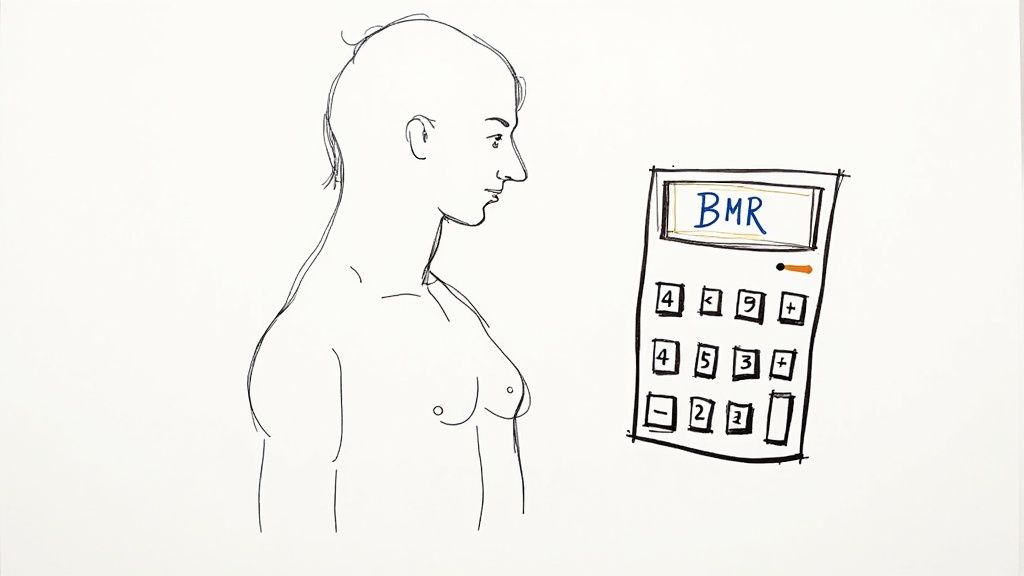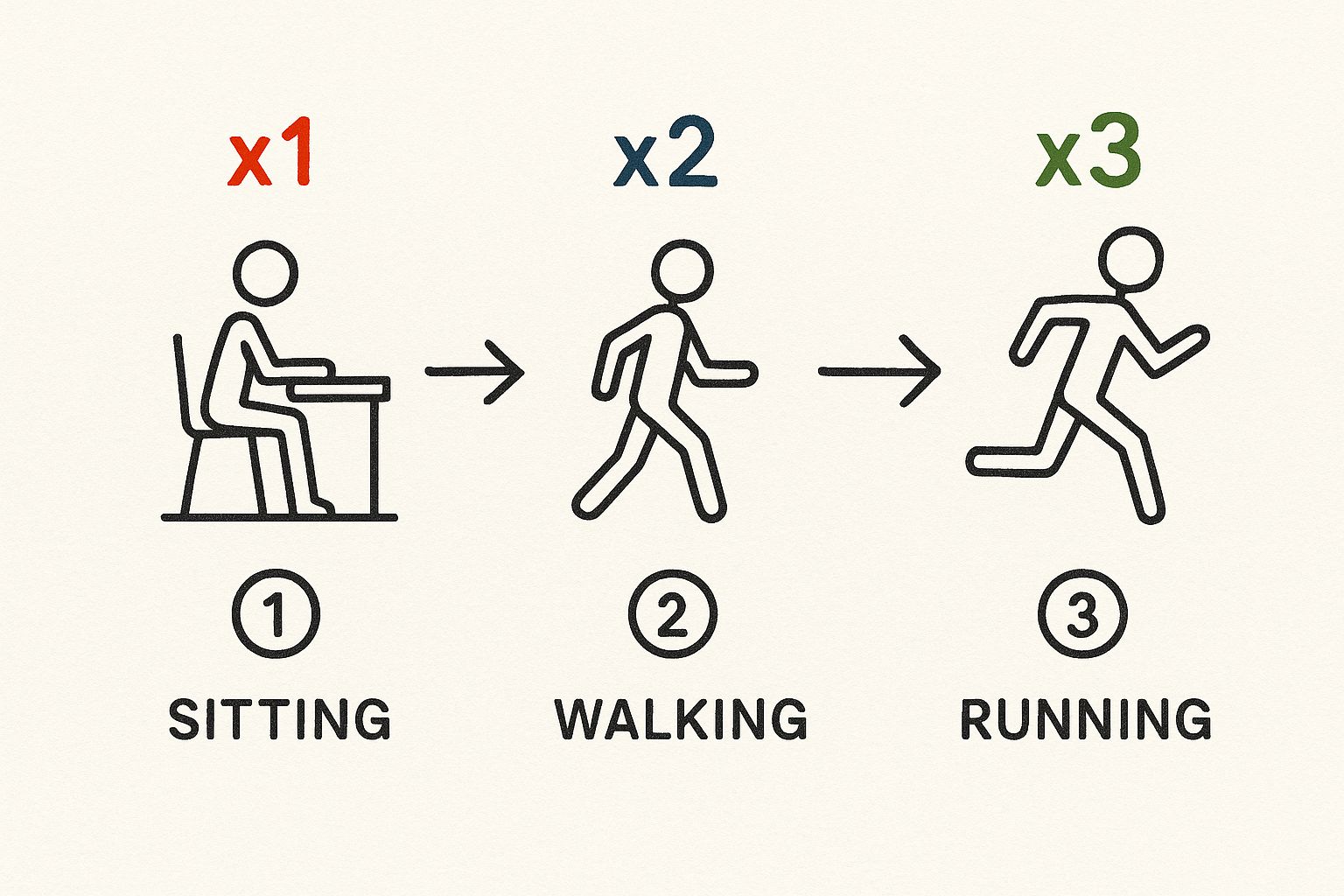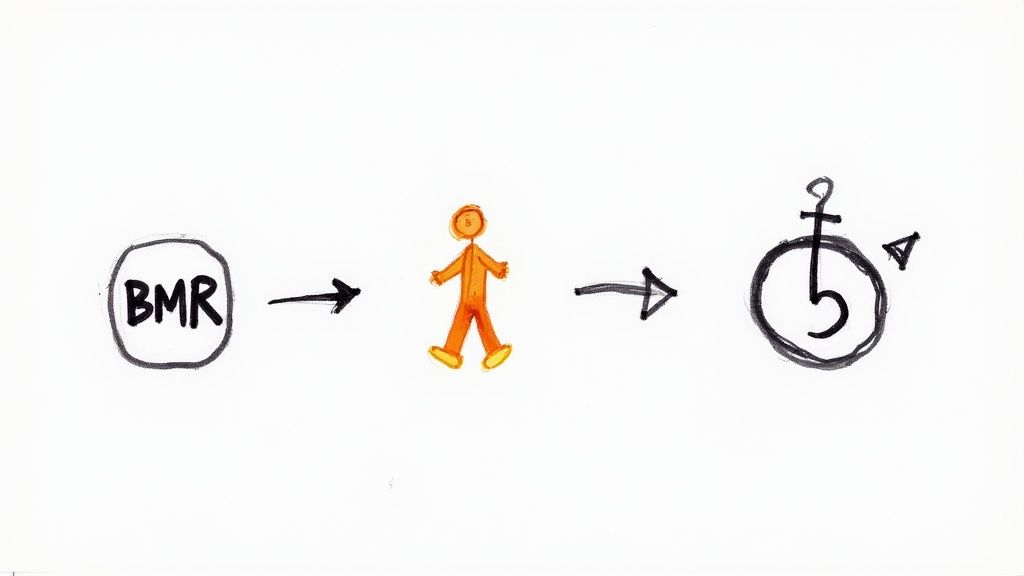How to Calculate Your Daily Calorie Needs (Without the Stress)
Learn how to calculate daily calorie needs with our simple, stress-free guide. Find your BMR and TDEE to understand your nutrition without complex math.
Posted by
Figuring out how many calories you need each day can feel like a complicated math problem, but it doesn’t have to be. It really just boils down to two simple ideas: your Basal Metabolic Rate (BMR) and your Total Daily Energy Expenditure (TDEE).
Think of your BMR as the energy your body needs just to keep the lights on—breathing, circulating blood, all the background stuff. Your TDEE is the total number of calories you burn once you factor in your actual life: walking to get coffee, hitting the gym, or typing at your desk. This number is your personal energy budget, and it's a fantastic starting point, not a rigid rule.
Your Personal Energy Budget, Simplified
Let's be honest, a lot of nutrition advice feels way too intense. My goal here is to cut through that noise. Figuring out your daily calorie needs isn’t about hitting a perfect number every single day. It’s about getting a feel for your body's unique energy budget.
Think of this less as a "diet" and more of a practical guide to getting curious about what your body needs to feel its best, without the pressure of obsessive tracking. After all, the real goal is to feel great while living your normal, busy life.
The Science in a Nutshell
So, how do we get this number? It all starts with well-established formulas that estimate your energy needs. These equations use your gender, age, weight, and height to figure out the bare minimum calories your body needs to function at rest.
From there, we adjust that baseline number by multiplying it with an "activity factor" to find your total daily calorie burn. This final number is a much more realistic estimate because it accounts for the energy you use just moving around. If you want to dive deeper, you can explore the nutritional science behind these calculations.
The number itself isn't the magic bullet. The real value comes from what you learn along the way. Think of it as a starting point for a conversation with your body, helping you tune into how different foods and activities make you feel.
This energy budget is entirely yours. For example, the calorie needs of a college student who walks across campus every day are worlds apart from someone who works from a home office. Grasping this simple difference is the first step toward making smarter, more intuitive food choices.
Ultimately, this isn't about restriction; it's about awareness. When you have a solid idea of your energy needs, logging what you eat—maybe just by speaking it into an app like munchlog.ai—stops being a chore and becomes a cool tool for insight, not judgment.
Finding Your Baseline with BMR

Before we can figure out your total daily calorie needs, we have to start at square one. This is your Basal Metabolic Rate, or BMR. It sounds technical, but the concept is super simple.
Think of your BMR as the number of calories your body needs just to keep the lights on. It’s the energy required to power your brain, keep your heart beating, and manage your breathing—basically, everything your body does on autopilot if you were to just chill in bed all day.
This number is your personal energy baseline, and it’s a big deal. For most of us, BMR accounts for a whopping 60-70% of our total daily calorie burn. It's the foundation we'll use to build a realistic picture of your actual energy needs.
What Goes into Your BMR
So, what actually determines this baseline number? It comes down to a unique mix of factors that are specific to you. The main ingredients are:
- Age: Our metabolism tends to slow down a bit as we get older. It's totally natural.
- Sex: Men generally have a higher BMR, typically because they carry more muscle mass on average.
- Height & Weight: Simply put, larger bodies require more fuel to run.
It's easy to see why a one-size-fits-all approach to calories just doesn't work. A 30-year-old remote worker who is 5'5" will have a very different BMR than a 22-year-old student who is 6'0" and walks everywhere—and that's before we even talk about their workouts.
One of the most trusted methods for estimating this is the Harris-Benedict formula. It's been around since 1919 (with updates, of course) and gives a really solid BMR estimate. For men, the formula looks like this: 88.362 + (13.397 × weight in kg) + (4.799 × height in cm) – (5.677 × age in years). If you're curious, you can dive deeper into the science behind BMR formulas and how they function.
Don't worry, you don't need to break out a calculator! Most online tools and apps handle this math for you. The key is understanding what this number represents—your body’s essential energy needs at complete rest.
Once you have this baseline figure, you're one step closer to figuring out how to calculate daily calorie needs that truly match your lifestyle. Your BMR is the first piece of the puzzle. Now let’s get to the fun part: adding in all your daily activities.
Factoring in Your Daily Movement with TDEE
Your BMR is a fantastic starting point, but let’s be real—most of us don't spend the entire day lying perfectly still. This is where your Total Daily Energy Expenditure (TDEE) comes in. It takes that baseline BMR and adds in all the energy you burn just living your life.
Think about it. Everything from your commute and a workout to typing at your desk and even fidgeting counts. TDEE gives you a much more realistic picture of your daily calorie needs because it accounts for your unique lifestyle.
Find Your Daily Activity Level
To calculate your TDEE, you'll multiply your BMR by an "activity multiplier." It sounds technical, but it’s really just a number that represents your general activity level. Be honest with yourself here—choosing the right one is key to getting an accurate result.
The more active you are, the higher the multiplier, which means you burn more calories every day. This simple chart breaks it down.

This table provides a simple breakdown of activity multipliers to help you calculate your Total Daily Energy Expenditure (TDEE) from your Basal Metabolic Rate (BMR).
| Activity Level | Description | Multiplier |
|---|---|---|
| Sedentary | Desk job with little or no intentional exercise. | 1.2 |
| Lightly Active | Light exercise or walks 1-3 days per week. | 1.375 |
| Moderately Active | Moderate exercise or gym sessions 3-5 days per week. | 1.55 |
| Very Active | Physically demanding job or hard exercise 6-7 days per week. | 1.725 |
Once you've identified your multiplier, the final calculation is easy. You just multiply your BMR by that number.
Let’s say a student has a BMR of 1,600 calories. If they are mostly sedentary studying for exams, their TDEE would be 1,600 x 1.2 = 1,920 calories. But if they walk to class and hit the gym a few times a week, they might be moderately active. That number jumps to 1,600 x 1.55 = 2,480 calories. A simple shift in habits makes a huge difference.
Matching Your Calories to Your Personal Goals
So, you've got your TDEE number. What's next? This is where you can connect that number to what you actually want to achieve. It’s less about hitting a perfect target every day and more about making smart, sustainable adjustments.
Whether you're looking to maintain your current weight, lose a little body fat, or build muscle, it all comes down to a small, intentional shift in your daily intake. Forget drastic cuts. We're talking about a gentle nudge of about 300-500 calories in one direction or the other.

Setting Your Target
Let's put this into practice. Your TDEE is essentially your "maintenance" number. Eating around this level should keep your weight pretty stable. To gently tip the scales, you just introduce a small deficit or a small surplus.
For Sustainable Weight Loss: The goal is a modest calorie deficit. This just means eating slightly fewer calories than your TDEE. A 300-calorie deficit could be as simple as swapping a daily sugary latte for a black coffee and having a handful of nuts instead of a bag of chips. Easy.
For Building Muscle: Here, you'll want a slight calorie surplus. Eating a bit more than your TDEE gives your body the extra energy it needs to repair and build new muscle tissue, especially if you’re strength training.
The real secret is consistency, not perfection. A small daily adjustment, repeated over weeks and months, is far more powerful and way less stressful than any crash diet. You're building habits, not just chasing a number.
This is exactly why casually logging your food can be such a game-changer. It gives you a clear, judgment-free look at your habits. If you're just starting out, our guide on how to track calories has some great, low-stress tips to get you going.
Why the Quality of Your Calories Matters
https://www.youtube.com/embed/22PRb9wXFxI
Alright, so you’ve figured out your daily calorie number. That's a huge step, but it's really just the first part of the story. The quality of those calories—what you're actually eating to hit that number—is what truly makes a difference in how you feel and perform.
Let's be real: 500 calories from a box of donuts hits your body a lot differently than 500 calories from grilled chicken and roasted veggies. This is where we need to talk about macronutrients.
The Big Three Macronutrients
Don't get intimidated by the scientific-sounding name. "Macros" are just a simple way of grouping food into three main buckets: proteins, carbohydrates, and fats. Each one has a specific job to do.
- Protein: Think of this as the body's construction crew. It's essential for building and repairing muscle, but it also plays a huge role in keeping you feeling full and satisfied after a meal.
- Carbohydrates: This is your body's favorite fuel source. Carbs give your brain and muscles the energy to power through your day and your workouts.
- Fats: Absolutely essential for producing hormones, absorbing certain vitamins, and providing a steady, long-lasting source of energy.
Getting a handle on this basic breakdown is honestly more important than obsessing over a perfect calorie target. Once you start seeing food this way, you make better choices instinctively. You'll know that a scoop of Greek yogurt is a great way to bump up your protein or that avocado toast gives you healthy fats and carbs.
If you want a more scientific starting point, tools like the USDA's DRI Calculator can be insightful. It takes your personal stats and gives you a solid baseline.
This calculator breaks down what the official Dietary Reference Intakes (DRIs) recommend. For most adults, that means getting:
- 45-65% of daily calories from carbohydrates
- 10-35% from protein
- 20-35% from fats
You can plug in your own numbers and explore your DRI estimates to get a personalized guideline straight from the source.
Common Questions About Your Calorie Target
Diving into this stuff always brings up a few questions. It’s completely normal to wonder if you’re getting it "right," so let's clear up some of the most common ones. Just remember, the goal here is to find a solid starting point, not to chase some impossibly perfect number.
How Often Should I Recalculate My Calorie Needs?
This is a big one. You don't need to do it every week, but you shouldn't just set it and forget it forever, either. A good rule of thumb is to check in after any significant change in your body or lifestyle.
Have you lost or gained 10+ pounds? That's a great time to recalculate. Did you switch from a desk job to one where you're on your feet all day? Your energy needs will definitely be different. Your body is always adapting, and your calorie target should, too.
What's the Really Accurate Way to Figure This Out?
Okay, so what’s the best method for finding your TDEE? While the formulas we've discussed are fantastic for getting a baseline, nothing beats paying attention to what's happening in the real world—with your own body.
The most accurate approach is to track your food intake and your weight for a couple of weeks. I know, it sounds like a chore, but it's incredibly revealing. Simply logging what you eat, even just by speaking it into an app, shows you what your current intake actually is. When you see how your weight responds to that number, you discover a TDEE that’s truly customized to you.
Think of it like this: the formulas give you an educated guess, but tracking gives you the real-time data. It’s the difference between looking at a weather forecast and just looking out the window.
Are Online Calculators a Waste of Time?
Not at all! In fact, for most people, they're the perfect place to start. An online TDEE calculator uses the exact same trusted formulas we've talked about, and it does all the math for you in seconds.
It’s a brilliant, stress-free way to figure out how to calculate daily calorie needs and get a reliable baseline. The point isn’t to achieve flawless precision on day one; it's about getting a helpful guideline you can use to start building more mindful habits.
Ready to stop guessing and start understanding your nutrition effortlessly? With munchlog.ai, you can track your meals just by speaking. Get your personalized insights and make mindful eating a simple part of your day. Try munchlog.ai today!